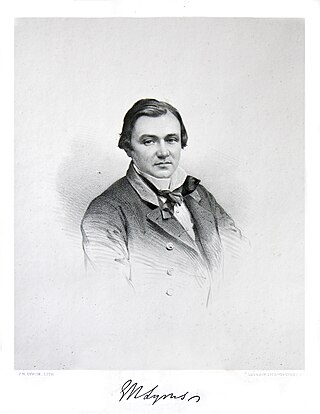
Captain Edmund Moubray Lyons was an officer of the Royal Navy. He served during the early nineteenth century, and was mortally wounded while commanding HMS Miranda in the Crimean War.
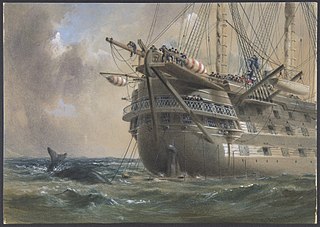
HMS Agamemnon was a Royal Navy 91-gun battleship ordered by the Admiralty in 1849, in response to the perceived threat from France by their possession of ships of the Napoléon class.
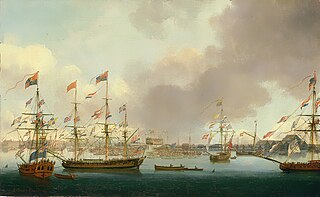
HMS Alexander was a 74-gun third-rate of the Royal Navy. She was launched at Deptford Dockyard on 8 October 1778. During her career she was captured by the French, and later recaptured by the British. She fought at the Nile in 1798, and was broken up in 1819. She was named after Alexander the Great.

Admiral Sir Sydney Colpoys Dacres was an officer of the Royal Navy who saw service during the Greek War of Independence, when he was involved in an attack on the Turkish forces at Morea, and later during the Crimean War. Born into a substantial naval dynasty during the Napoleonic Wars, he eventually rose to the rank of Admiral and became First Naval Lord. His only significant action as First Naval Lord was to press for the abolition of masts. He went on to be Visitor and Governor of Greenwich Hospital.

HMS Windsor Castle was a triple-decker, 102-gun first-rate Royal Navy ship of the line. She was renamed HMS Cambridge in 1869, when she replaced a ship of the same name as gunnery ship off Plymouth.

HMS Diadem was a 64-gun third rate ship of the line of the Royal Navy, launched on 19 December 1782 at Chatham. She participated in the Battle of Cape St Vincent in 1797 under Captain George Henry Towry.

HMS Terrible was when designed the largest steam-powered wooden paddle wheel frigate built for the Royal Navy.

HMS Sans Pareil("Without Equal") was an 80-gun third rate ship of the line of the Royal Navy. She was formerly the French ship Sans Pareil, but was captured in 1794 and spent the rest of her career in service with the British.
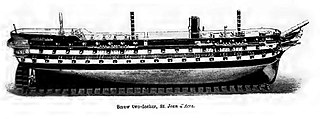
HMS St Jean d'Acre was the Royal Navy's first 101 gun screw two-decker line-of-battle ship. She served in the Crimean War.
HMS Nonsuch was a 36-gun fifth rate of the Royal Navy. She was an experimental fast-sailing design, built by the renowned shipwright Anthony Deane according to proposals by the Dutch naval officer Laurens van Heemskirk, who became her first captain. She was launched in December 1668, and commissioned the same day under van Heemskirk. In 1669 she was reclassed as a 42-gun Fourth rate, being commanded from 9 April by Captain Sir John Holmes. She was to spend most of her career in the Mediterranean. She was for a time based on Tangier, and was commanded by a succession of accomplished commanders who subsequently rose to flag rank in the Navy, including George Rooke from 1677 to 1680, then briefly under Cloudesley Shovell, and then Francis Wheler from 1680 to 1681. Under Wheler's command, she participated on 9 April 1681 in the capture of the Algerine 46-gun Golden Horse, along with the Fourth rate Adventure.

HMS Royal Albert was a 121 gun three-decker ship of the Royal Navy launched in 1854 at Woolwich Dockyard. She had originally been designed as a sailing ship but was converted to screw propulsion while still under construction.

HMS Carysfort was a 28-gun Coventry-class sixth-rate frigate of the Royal Navy. She served during the American War of Independence, the French Revolutionary and the Napoleonic Wars in a career that spanned over forty years.

Rochfort Maguire was an Irish Royal Navy officer who served as captain of HMS Plover from 1852 to 1853 during the Franklin search expedition.

HMS Niger was originally slated to be built as a Sampson designed sloop; however, she was ordered as a First-Class sloop with screw propulsion on 20 February 1845 to be built at Woolwich Dockyard, along the design developed by Oliver Lang and with a hull like the Basilisk designed paddle sloops. Her armament and engine were to be like the Encounter Design building at Pembroke. A second vessel (Florentia) was ordered on 26 March 1846 but after her keel was laid at Pembroke Dockyard, her construction was suspended on 6 October 1846 then cancelled three years later, on 22 May 1849. Niger She conducted important propulsion trials, finally proving the superiority of screw propulsion and served in West Africa, the Crimea, China, the East Indies and Australia. She took part in the New Zealand wars in 1860 and was sold for breaking in 1869.

HMS James Watt was a 91-gun steam and sail-powered second rate ship of the line. She had originally been ordered as one of a two ship class, with her sister HMS Cressy, under the name HMS Audacious. She was renamed on 18 November 1847 in honour of James Watt, the purported inventor of the steam engine. She was the only Royal Navy ship to bear this name. Both ships were reordered as screw propelled ships, James Watt in 1849, and Cressy in 1852. James Watt became one of the four-ship Agamemnon-class of ships of the line. They were initially planned as 80-gun ships, but the first two ships built to the design, HMS Agamemnon and James Watt, were rerated on 26 March 1851 to 91 guns ships, later followed by the remainder of the class.
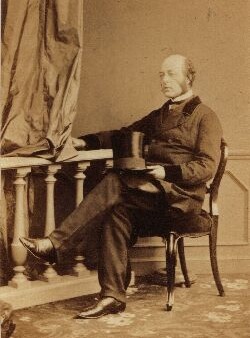
Admiral Sir Arthur Cumming was an officer of the Royal Navy.

HMS Phoenix was a 6-gun steam paddle vessel of the Royal Navy, built in a dry dock at Chatham in 1832. She was reclassified as a second-class paddle sloop before being rebuilt as a 10-gun screw sloop in 1844–45. She was fitted as an Arctic storeship in 1851 and sold for breaking in 1864.

HMS Encounter was ordered as a First-Class Sloop with screw propulsion on 5 February 1845 to be built at Pembroke, in accordance with the design developed by John Fincham, Master Shipwright at Portsmouth. Her armament was to consist of 8 guns. She was to have a more powerful steam engine rated at 360 nominal horsepower. In 1848 she would be altered abaft and lengthened at Deptford prior to completion. A second vessel (Harrier) was ordered on 26 March 1846 but after her keel was laid at Pembroke Dockyard, her construction was suspended on 9 September 1846 then cancelled five years later, on 4 April 1851. Encounter had her armament radically altered in 1850 and she was broken up at Devonport in 1866.
George Pechell Mends was an English sailor and amateur artist.
Conflict was originally slated to be built to the Sampson designed steam vessel rated as a Steam Vessel First Class (SV1); however, the Admiralty, first rerated the vessels as First Class Sloops on 19 April 1845 then on 9 May 1845, she was ordered from a design of Sir William Symonds,Surveyor of the Navy. Originally designated as 10-gun vessels with 400 NHP engines. She served in the Baltic during the Russian war of 1854 - 55. She was sold for breaking in 1863.


















